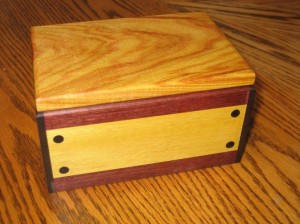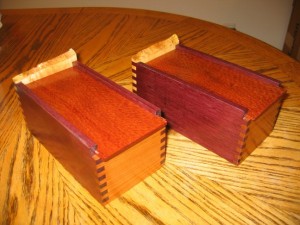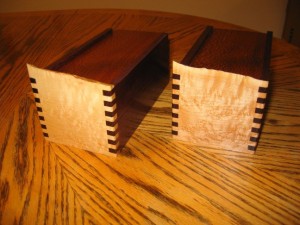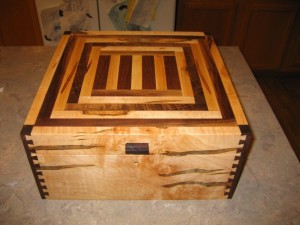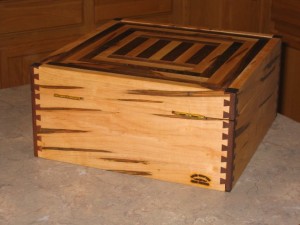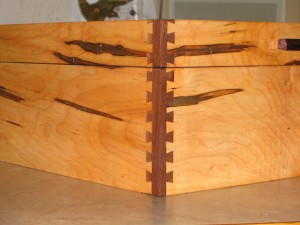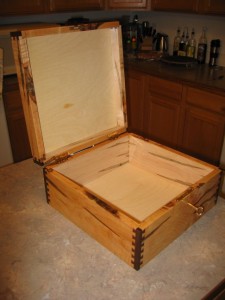In reply to post Tapered Box
Don K. replied:
Beautiful…bet she will like this almost as much as the pendant. I real keep sake !!!!
scrappy replied:
Very nice box. Like the tapered sides/lid and great choice of woods.
Keep it up.
TopamaxSurvivor replied:
Fantastic!! Definitely beats a cardboard box :-))
trimtrac replied:
That’s a nice box. I need to read that fellows book
blockhead replied:
Beautiful job! Love the design and choice of woods.
ellen35 replied:
Great box! Design and execution outstanding…purpose noble!
SPalm replied:
Very nice take off on a classic box. Well done.
Tapering the sides must have been exciting. Especially the forth side. Any tips on how you did it, as in how you held it while slicing?
Steve
patron replied:
beautifull box !
simple and elegant .
i think i hear quasimoto ,
tuning his bells ,
for the big day !
jockmike2 replied:
Very beautiful box. unique too.
michaelray replied:
Great looking box. Nice choice of colors and excellent job on ‘wrapping’ the grain around the sides.
jhawkinnc replied:
Very nice! You’ve set a big precedent for all future gifts, though. 🙂
Innovator replied:
Beautiful box.
SnowyRiver replied:
Great work. Beautiful.
majeagle1 replied:
A real pretty box !
I love the spalted woods and the padauk adds the right contrast and really makes it stand out.
The tapered design is very nice also………. Job well done, thanks for sharing.
dustyal replied:
Nice job making wrapping paper… lol. I enjoy browsing and picking up on box ideas. Thanks for including the part on how you tapered it… I’m an amateur and probably would have tried to cut the tapers, then mitered.. and then.. toss it all out.
So, the side walls are thinner at the top than at the bottom—maybe tapering in thickness from half to three quarter thick? Box isn’t so tall that your saw depth could cut all the way from top to bottom? I might need to try this on some cheap poplar first…
Thanks for sharing…
ratchet replied:
Nice box! I really like the spalting and color contrast. What keeps the box lid from seating all the way?
coloradoclimber replied:
Thanks all for the kind comments. It was a fun box to make and cranked out pretty fast.
Simple answers first. The lid has a small step set back from the outer edge to keep the big part of the lid lifted off of the box. The idea was to have a small gap so the lid looks like it is “floating” just off of the box. You can only see the gap from straight on or lower but if she sets it on a high shelf you should be able to see it. Or maybe it will be a design element that will never be noticed, except by another woodworker :). I cut the rabbet around the lid on the table saw, cut with the lid flat and then with the lid on edge. I made the two cuts shy of meeting in the corner so it left the step all around the rabbet. The lid just barely fits into the box so the lid stops high and rests on the step leaving the small gap.
Yep, the box tapers from thick at the bottom, 3/4 of an inch or so at the bottom to maybe 1/2 inch thick at the top. The box is a typical mitered corner box made from 3/4 or so stock. It looks pretty thick and clunky before it is tapered. Add in the miter keys while it’s still square using a standard 45 degree sled run over the table saw blade. I even cut the lid square and sized the rabbet and step while the box was square. Once it’s all dry you cut the tapers.
Cutting the tapers was the slightly tricky part, not a big deal but that’s a lot of blade exposed. First I did a quick pass with a block plane over the miter keys to get the sides mostly flat. I did not have to worry about scuffing the sides since I was about to slice them off. Mostly the sides need to be reasonably flat so you can register a side against your miter fence.
I like to make my cuts so that the off cut falls away under the tilted blade. I dont like the idea of an off cut riding free on top of the spinning blade. So since I wanted the off cut to be on the bottom side of the blade I had to cut the sides with the box upside down. The open top of the box was riding on the table saw table with the blade tilted away from the bottom of the box. The first two cuts were pretty easy and pretty safe. Since the box is still square sided at this point I pushed one flat side against the miter fence and put a F clamp on it to hold the box against the fence. I then sliced off one end. Flip the box around to get the other flat face against the miter fence, clamped it, and sliced off the another face.
That left me with a box with flats on two sides and tapers on two sides. Now comes the dicey part. Freedman’s book suggests making tapered seats for your miter fence and opposite clamping face so you can get a good clamp while holding the tapered sides. That sounds like a good idea to me, that’s my recommendation for anyone else trying this. I ended up free handing it for the remaining two side. I held the upside down box with the tapered side against the miter fence and sliced off the other two sides. It was a little spooky but mostly I kept my dang fingers back and crept up on it gentle, that’s a lot of blade exposed.
Dusty56 replied:
This is Ambrosia Maple , not Spalted Maple if you want to correct your post.
If you notice , the little holes in it are left behind as the Ambrosia Beetle grub bores its way through the Maple tree . The staining is a reaction by the tree caused by the boring process.
Spalted Maple is characterized as black “pencil” lines caused by a fungus in the wood as the tree starts to decompose.
Very nice gift box and you did a great job matching the grain on the corners : )
Blake replied:
So cool. Love the shape, love the colors, love the wormy figure.
coloradoclimber replied:
Dusty,
Thanks for the heads up. I’ll have to do a little more research and correct my postings. I bought a few sticks of this maple, saw the bug holes, saw what looked to me like spalting, and assumed that was what it was. I did not realize the beetle tracks also resulted in staining like this.
coloradoclimber replied:
Dusty,
After some “quick” research, so don’t hold be too strongly to this, I think there is some confusion.
I could not find a formal definition for spalting but the consensus seems to be something like:
”Spalting is any form of wood coloration caused by fungi.”
and
”Spalting is caused by the infections of wood with various kinds of white rot fungi. The characteristic blue-black zone lines of spalted wood form when incompatible colonies of fungi come into contact with each other and lay down barriers to separate their territories.”
I also read:
”Ambrosia beetles are beetles of the weevil subfamilies Scolytinae and Platypodinae (Coleoptera, Curculionidae), which live in nutritional symbiosis with ambrosia fungi and probably with bacteria. The beetles excavate tunnels in dead trees in which they cultivate fungal gardens, their sole source of nutrition. After landing on a suitable tree, an ambrosia beetle excavates a tunnel in which it releases spores of its fungal symbiont. The fungus penetrates the plant’s xylem tissue, digests it, and concentrates the nutrients on and near the surface of the beetle gallery.”
So based on this my take is spalting is the more general term. A fungus discolored wood is spalted. How the fungus got there is more specific. It sounds like the ambrosia beetle carries a particular fungus that it likes and that fungus causes splating. From my read it doesn’t sound like the boring so much causes the discoloration as the fungus spores carried along by the beetle as it bores around.
So I would say this maple is spalted. It may be the particular spalting comes from the fungus carried by the ambrosia beetle so it might be more precise to say ambrosia maple but my read is that spalting is a more general term and is correct.
An interesting side note:
”Dark dotting, winding lines and thin streaks of red, brown and black are known as zone lines. This type of spalting does not occur due to any specific type of fungus, but is instead an interaction zone in which different fungi have erected barriers to protect their resources”
SPalm replied:
Mr. Climber,
Your explanation is correct and how I had always heard it. It is the fungi doing the discoloration and spalting, no matter how it got there. (My first wife is one of the country’s top fungi experts).
I was also told that wormy wood was named because of the holes and tracks laid down by insects, not the color variations. But I have seen several hits on the web that use these interchangeably.
Steve
Dusty56 replied:
Perfect example of SPALTED MAPLE http://hobbithouseinc.com/personal/woodpics/maple,%20spalted.htm
Perfect examples of AMBROSIA MAPLE http://www.haleydaniels.com/maple-ambrosia.jpg
as known to 99 and 44/100% of woodworkers that have seen both.
I am not denying that a fungus causes both the streaking and the lines, however, your box is made from Ambrosia Maple is all that I’m saying.
Notice that there are NO holes in the actual Spalted Maple sample picture, just the black lines that I mentioned before.
I have also recently seen Curly Spalted Ambrosia Maple for sale, but you could clearly see all of the individual figures in the wood. ie: the Curl, The Spalted areas and also the Stained areas from the Ambrosia Beetle boring through the wood and introducing its particular fungus in its wake.
Let me put it to you this way … if you said that you were building a table out of Spalted Maple and needed just one more piece of it to make a replacement front leg and I told you that I had one for you and then showed up with Ambrosia Maple ….what would you do ? Ooops , sorry I forgot that they are the same thing to you. Bad example…..I’d use Oak for an example , but you probably think that Red and White Oak are the same thing as well.
Better yet , what if you had sent your wife to the lumber yard to get it and she came home with the “other” one? Would you say it was Ok to her because they are the same thing in your eyes?
Hmmmm…Squiggly pencil lines versus beetle holes and staining…Oh my!!
— When you arrive at my front door, please knock softly but firmly. I like soft , firm, knockers : )
coloradoclimber replied:
It seems to me the fault would be mine. If I told my wife to “just pick me up some oak” and she brought home whatever was at the store, red or white, she would be without fault (which if you’ve ever been married had better be the answer on the tip of your tongue :)).
If I want something specific the burden is on me to specify what I want. If I want wormy maple or beetle kill or ambrosia beetle infected maple the burden is on me to make that clear. If I want spalted with no beetle holes or worm tracks I better specify that. If I just want some moldy old wood I guess it wouldn’t matter.
It may be that 99.44% of all woodworkers who ever viewed the infinite varieties of fungus infected maple would immediately and without hesitation assert with great vigor the unique differences between beetle infected and simply rotted, I’m not that wound up. Although I do question your statistics. A simple google search did not turn up a clear and definitive answer, nothing on the order of 99.44%. Or maybe google just happened to divert me into the ignorant 0.56% of the definitions and web pages.
If 99.44% of woodworkers like to call this wood ambrosia maple, I’m cool with that. I agree that ambrosia maple seems to be a more precise answer. It seems clear the spalting in this wood is directly related to being infested by the ambrosia beetle. It is still not clear to me this is not spalted maple, looks pretty fungified to me. Anyhow, if you want to call this ambrosia maple and you think my calling it spalted maple displays an ignorance vast beyond measure, I’m cool with that too.
As a near meaningless side note the lumberyard where I purchased it had a whole stack just like this and it was labeled and sold as spalted maple.
Dusty56 replied:
http://www.turningblanks.net/servlet/the-Ambrosia-Maple/Categories
”displays an ignorance vast beyond measure”…..I would never say that about you. I will however say it about the lumber company that you say is selling this as Spalted Maple.
I was only trying to point out that your particular “spalting”as you call it , was due to the Ambrosia beetles activities. That is why it is known as Ambrosia Maple.
Check out these links that clearly distinguishes one from the other.
http://www.heirloomwoodcrafting.com/sawmilling_spalted.htm
http://www.heirloomwoodcrafting.com/sawmilling_ambrosia.htm
Also , Spalting occurs from a fungus reacting with a dead or dieing tree whereas the Ambrosia Beetle staining is spread throughout a living tree by the sap flowing through the wood fibers.
coloradoclimber replied:
hmmm,
I’ll have to investigate that when I get a few more moments. If things are as your last sentence suggests, “Ambrosia Beetle staining” then that may be different that spalting.
If the discolorations are caused by something other than fungus, some staining that is unique to the attack of the ambrosia beetle, then is seems reasonable to differentiate ambrosia beetle stained wood from general fungus discolored wood.
From what I read, albeit limited reading, the marks, lines, and discolorations in the beetle infested wood are from the fungus carried by the beetle. The discolorations are caused by the fungus and therefore fall under the general heading of spalting, that is assuming you believe the statement ”Spalting is any form of wood coloration caused by fungi.”
If on the other hand the discolorations are caused by something other than fungus there may be more to this.
I will chase your links and see what they tell me. You never know what you’ll learn bouncing off of other people.
bigike replied:
cool box, nice contrasting woods
hershey11 replied:
Thx. This’s useful, as at first glance the farmer may think there is no difference.














